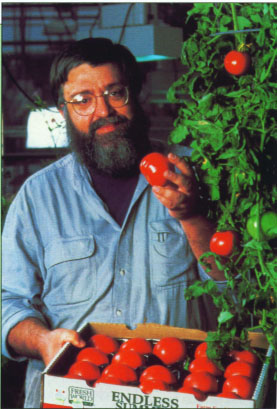All Issues
The case of the FLAVR SAVR tomato
Publication Information
California Agriculture 54(4):6-7.
Published July 01, 2000
PDF | Citation | Permissions
Full text
The FLAVR SAVR tomato was the first genetically engineered crop product to be commercialized. The research and marketing efforts that produced the FLAVR SAVR tomato resulted in scientific success, a temporary sales success, and then commercial demise. The FLAVR SAVR story reveals how difficult it can be to bring genetically engineered products to market, how objections with little or no scientific merit can influence the outcome, and how important public opinion is in determining commercial success.
Circumstantial evidence available in the 1980s suggested that the tomato fruit enzyme polygalacturonase (PG), because of its ability to dissolve cell-wall pectin, was key to fruit softening. Researchers at Calgene, Inc., in Davis, proposed to suppress PG accumulation in ripening tomatoes by introducing a reverse-orientation copy of the gene, an “antisense” copy designed to prevent or drastically reduce the formation of PG.
Their expectation was that ripe fruit would remain firm longer, perhaps even allowing it to be transported to market after vine-ripening. Transporting vine-ripened fruit would avoid the practice of picking green fruits and artificially ripening them by ethylene treatment, which gives a ripe tomato color but not the full array of vine-ripened tomato flavors.
By 1987, Calgene researchers identified and cloned a tomato fruit PG gene, developed methods for tomato transformation and regeneration, and produced tomato plants with inserted PG antisense DNA constructions. Some of the resulting tomato lines generated as little as 1% of the PG found in conventional tomatoes. Based on the results from eight contained field trials, in October 1992 the U.S. Department of Agriculture determined that the PG-antisense tomato lines were not a “plant-pest” risk and no longer required permits for field testing or transport.
In May 1994, the U.S. Food and Drug Administration, responding to a Calgene petition, approved the introduction of kanamycin-resistance gene constructions needed to create the PG-antisense tomato lines.
Kanamycin-resistant organisms in human and animal guts and in soil were determined to be so common and abundant that they would overcome any potential influence of the corresponding genes in engineered crop plants. Allergic reactions to the kanamycin-resistance protein were also determined to be highly unlikely.
Data submitted by Calgene, including animal feeding studies, showed the PG-antisense tomato to be indistinguishable in almost every way from traditional tomatoes. The exceptions were that fruit cell-wall pectin degraded more slowly, and tomato paste had a higher viscosity (Redenbaugh et al. 1992; Martineau 1997).
Paralleling Calgene's efforts to develop the PG-antisense tomato lines, the company began to gain experience in the conventional fresh-market tomato business and to meet with community leaders, media representatives and consumers in Davis and Chicago, the two sites selected for initial introduction of the FLAVR SAVR tomato. On May 21, 1994, the genetically engineered FLAVR SAVR tomato was introduced. Demand for this product was high and remained high, but the product was never profitable because of high production and distribution costs.
In 1996, Zeneca, under license, introduced in the United Kingdom paste from PG-antisense tomatoes grown and processed in California, in collaboration with the grocery chains Sainsbury's and Safeway. More than 1.8 million cans, clearly labeled as derived from genetically engineered tomatoes, were sold from 1996 through early 1999. Reduced processing costs allowed a 20% lower price. The paste from genetically engineered tomatoes initially out-sold conventional tomato paste at many locations, but sales of this product declined dramatically in fall 1998. Subsequently, Safeway and Sainsbury's declared that their house brands would not have genetically engineered ingredients, to satisfy the stated concerns of some customers rather than for any reason of food safety.
A report of a select committee of the U.K. House of Commons (1999), suggests that the decline in sales of the Zeneca tomato paste can be traced to an August 1998 British broadcast featuring Dr. Arpad Pusztai and subsequent media attention to the broadcast. He announced his conclusion that feeding rats genetically modified potatoes resulted in biological effects that “could” be attributed to the process of genetic engineering, rather than to the product of the introduced gene (Ewen and Pusztai 1999). Subsequently, independent analysis of the data, commissioned by Dr. Pusztai, and his testimony to the select committee (U.K. House of Commons 1999), both indicate that the conclusions stated in the broadcast are incorrect. However, the Zeneca product has not returned to grocery store shelves, with a corresponding loss to California agriculture.
Research to control the ripening of tomatoes continues. At UC Berkeley, Athanasios Theologis and colleagues have identified and blocked a gene responsible for ripening. Fruit of this tomato and of similarly modified crops are ripened “on command” by treating on the vine with ethylene, giving freshness, improved flavor and reduced spoilage.
Demand for the FLAVR SAVR tomato was high and remained high, but the product was never profitable.





